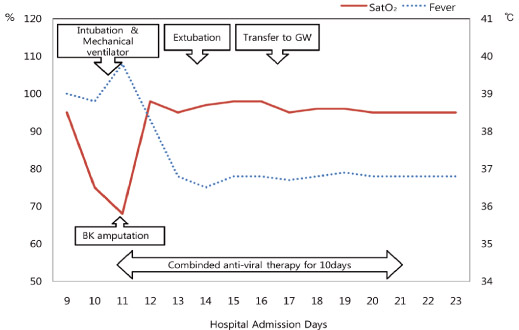Infect Chemother.
2010 Apr;42(2):117-121.
Two Cases of Respiratory Distress Syndrome Caused by Hospital-Acquired Pandemic Influenza (H1N1 2009) in Kidney Transplant Recipients
- Affiliations
-
- 1Department of Internal Medicine, Soonchunhyang University School of Medicine, Seoul, Korea. ksoonhyo@hosp.sch.ac.kr
Abstract
- Since pandemic influenza was declared by WHO at June 2009, severe pandemic influenza cases were reported among pregnant, obese, immunocompromised patients including transplant candidates and recipients were reported. Here we report two cases of pandemic influenza (H1N1 2009) with respiratory distress syndrome in adult patients with kidney transplantation. They were successfully treated with combination of antiviral therapy including high dose oseltamivir. Although clinical symptoms and signs were improved immediately when anti-viral therapy was started, radiologic finding resolved after several weeks.
MeSH Terms
Figure
Reference
-
1. Centers for Disease Control and Prevention(CDC). Intensivecare patients with severe novel influenza A (H1N1) virus infection - Michigan, June 2009. MMWR Morb Mortal Wkly Rep. 2009. 58:749–752.2. Perez-Padilla R, de la Rosa-Zamboni D, Ponce de Leon S, Hernandez M, Quiñones-Falconi F, Bautista E, Ramirez-Venegas A, Rojas-Serrano J, Ormsby CE, Corrales A, Higuera A, Mondragon E, Cordova-Villalobos JA. INER Working Group on Influenza. Pneumonia and respiratory failure from swine-origin influenza A (H1N1) in Mexico. N Engl J Med. 2009. 361:680–689.
Article3. Vaillant L, La Ruche G, Tarantola A, Barboza P. epidemic intelligence team at InVS. Epidemiology of fatal cases associated with pandemic H1N1 influenza 2009. Euro Surveill. 2009. 14:pii:19309.
Article4. Turner B, Murch L. Interscience Conference on Antimicrobial Agents and Chemotherapy-49th annual meeting. Part 1. 11-15 September 2009, San Francisco, CA, USA. IDrugs. 2009. 12:667–669.5. Watcharananan SP, Suwatanapongched T, Wacharawanichkul P, Chantratitaya W, Mavichak V, Mossad SB. Influenza A/H1N1 2009 pneumonia in kidney transplant recipients: characteristics and outcomes following high-dose oseltamivir exposure. Transpl Infect Dis. 2010. [Epub ahead of print].
Article6. Munster VJ, de Wit E, van den Brand JM, Herfst S, Schrauwen EJ, Bestebroer TM, van de Vijver D, Boucher CA, Koopmans M, Rimmelzwaan GF, Kuiken T, Osterhaus AD, Fouchier RA. Pathogenesis and transmission of swine-origin 2009 A(H1N1) influenza virus in ferrets. Science. 2009. 325:481–483.
Article7. Maines TR, Jayaraman A, Belser JA, Wadford DA, Pappas C, Zeng H, Gustin KM, Pearce MB, Viswanathan K, Shriver ZH, Raman R, Cox NJ, Sasisekharan R, Katz JM, Tumpey TM. Transmission and pathogenesis of swine-origin 2009 A(H1N1) influenza viruses in ferrets and mice. Science. 2009. 325:484–487.
Article8. Writing Committee of the Second World Health Organization Consultation on Clinical Aspects of Human Infection with Avian Influenza A (H5N1) Virus. Abdel-Ghafar AN, Chotpitayasunondh T, Gao Z, Hayden FG, Nguyen DH, de Jong MD, Naghdaliyev A, Peiris JS, Shindo N, Soeroso S, Uyeki TM. Update on avian influenza A (H5N1) virus infection in humans. N Engl J Med. 2008. 358:261–273.
Article9. Lee N, Chan PK, Hui DS, Rainer TH, Wong E, Choi KW, Lui GC, Wong BC, Wong RY, Lam WY, Chu IM, Lai RW, Cockram CS, Sung JJ. Viral loads and duration of viral shedding in adult patients hospitalized with influenza. J Infect Dis. 2009. 200:492–500.
Article10. Nguyen JT, Hoopes JD, Smee DF, Prichard MN, Driebe EM, Engelthaler DM, Le MH, Keim PS, Spence RP, Went GT. Triple combination of oseltamivir, amantadine, and ribavirin displays synergistic activity against multiple influenza virus strains in vitro. Antimicrob Agents Chemother. 2009. 53:4115–4126.
Article11. Kim SH. Treatment of severe pandemic influenza A/H1N1 infection. Infect Chemother. 2009. 41:265–271.
Article12. Nichols WG, Guthrie KA, Corey L, Boeckh M. Influenza infections after hematopoietic stem cell transplantation: risk factors, mortality, and the effect of antiviral therapy. Clin Infect Dis. 2004. 39:1300–1306.
Article13. Louie JK, Acosta M, Winter K, Jean C, Gavali S, Schechter R, Vugia D, Harriman K, Matyas B, Glaser CA, Samuel MC, Rosenberg J, Talarico J, Hatch D. California Pandemic (H1N1) Working Group. Factors associated with death or hospitalization due to pandemic 2009 influenza A(H1N1) infection in California. JAMA. 2009. 302:1896–1902.
Article14. Centers for Disease Control and Prevention(CDC). Bacterial coinfections in lung tissue specimens from fatal cases of 2009 pandemic influenza A (H1N1) - United States, May-August 2009. MMWR Morb Mortal Wkly Rep. 2009. 58:1071–1074.15. Webb SA, Pettilä V, Seppelt I, Bellomo R, Bailey M, Cooper DJ, Cretikos M, Davies AR, Finfer S, Harrigan PW, Hart GK, Howe B, Iredell JR, McArthur C, Mitchell I, Morrison S, Nichol AD, Paterson DL, Peake S, Richards B, Stephens D, Turner A, Yung M. ANZIC Influenza Investigators. Critical care services and 2009 H1N1 influenza in Australia and New Zealand. N Engl J Med. 2009. 361:1925–1934.
Article16. Palacios G, Hornig M, Cisterna D, Savji N, Bussetti AV, Kapoor V, Hui J, Tokarz R, Briese T, Baumeister E, Lipkin WI. Streptococcus pneumoniae coinfection is correlated with the severity of H1N1 pandemic influenza. PLoS One. 2009. 4:e8540.17. Barlow GD. BSAC Council. Swine flu and antibiotics. J Antimicrob Chemother. 2009. 64:889–894.
Article18. Centers for Disease Control and Prevention(CDC). Surveillance for pediatric deaths associated with 2009 pandemic influenza A (H1N1) virus infection-United States, April-August 2009. MMWR Morb Mortal Wkly Rep. 2009. 58:941–947.19. Kumar D, Morris MI, Kotton CN, Fischer SA, Michaels MG, Allen U, Blumberg EA, Green M, Humar A, Ison MG. AST Infectious Diseases Community of Practice and Transplant Infectious Diseases Section of TTS. Guidance on novel influenza A/H1N1 in solid organ transplant recipients. Am J Transplant. 2010. 10:18–25.
Article
- Full Text Links
- Actions
-
Cited
- CITED
-
- Close
- Share
- Similar articles
-
- A Case of Pandemic 2009 H1N1 Influenza A Manifestation as Apical Ballooning Syndrome
- A Fetal Case of Pandemic Influenza (H1N1 2009) by the Aggravated Heart Faiure
- Swine Influenza A (H1N1) Infection in Renal Transplant Recipients
- The 2009 H1N1 Pandemic Influenza in Korea
- Early Extracorporeal Membrane Oxygenation in a Patient with Pandemic Influenza (H1N1 2009) and Acute Respiratory Distress Syndrome



